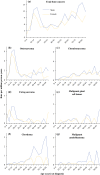Incidence patterns of primary bone cancer in taiwan (2003-2010): a population-based study
- PMID: 24723225
- PMCID: PMC4082651
- DOI: 10.1245/s10434-014-3697-3
Incidence patterns of primary bone cancer in taiwan (2003-2010): a population-based study
Abstract
Background: Primary bone cancer (BC) incidence by age has not been surveyed in Asia.
Methods: The incidence patterns of nine subtypes of primary BCs registered between 2003 and 2010 were analyzed from Taiwan cancer registry data. More specific analyses were conducted within age groups (Group I: 0-24 years; Group II: 25-59 years; and Group III: 60-85+ years).
Results: A total of 1,238 newly diagnosed subjects were registered with an age-standardized incidence rate (ASR) of 6.70 per million person-years. Overall, osteosarcoma (OS: 45 %) was the most common, followed by chondrosarcoma (CS: 18 %), and Ewing sarcoma (ES: 8 %). The percentages of cases and ASRs for age groups I, II, and III were 36.3, 43.0, and 20.7 %, and 7.00, 5.48, and 10.28 per million, respectively. Significant male predilections were observed for all BCs combined, and the CS, chordoma, and malignant ameloblastoma subtypes. Our findings demonstrated an upward trend of 4.8 % per year over the study period, and was more significant for females (6.7 %). A significant increase in trend existed in the incidence of BC among females in Group II, and the incidence of OS and ES among females in Group I.
Conclusions: This population-based study has allowed us to confidently define the incidence rates among three age groups of Taiwanese. Despite overall low rates, the upward trend in BC incidence among females may invoke a concern. The results suggest areas for further study into the underlying causes for these cancer trends.
Figures
References
-
- Guo W, Xu W, Huvos AG, Healey JH, Feng C. Comparative frequency of bone sarcomas among different racial groups. Chin Med J (Engl). 1999;112:1101–1104. - PubMed
MeSH terms
LinkOut - more resources
Full Text Sources
Other Literature Sources
Medical



